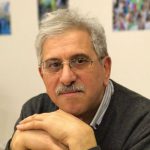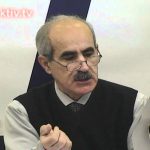“The images in “Heydaristan” were compiled in 2010-2012 by accident while working on other projects and stories with grants from National Geographic and Fulbright. At no point did I set out to document the personality cult of former KGB Chief, leader of Soviet and independent Azerbaijan, and the man who secured “the contract of the century” to build the Baku-Tbilisi-Ceyhan oil pipeline, Heydar Aliyev, also known locally as “the national leader.” He has become the subject of one of the world’s significant personality cults, with a recent effort to place a statue of Heydar in Mexico City’s Reforma Boulevard by the Azerbaijani government which met with a surprising and unusual measure of controversy and negative publicity, serving as the impetus for returning to my own work over the last three years.
Heydar Aliyev was the ruler of communist-era Azerbaijan from 1969 until he became the first Muslim member of the Soviet Politburo in 1982. From 1993 until his death in 2003, Heydar Aliyev was the president of independent Azerbaijan when his son Ilham was installed in the family business and inherited the country. While living in Azerbaijan, the presence of Heydar Aliyev is everywhere – on squares, statues, billboards; in offices, government buildings, and businesses; as the name of streets, parks, public works projects, arenas and concert halls. Heydar is both eery and comforting; the longer one spends in a specific authoritarian regime, the more one begins to rationalize and even justify the role and position of those in power. The symbols of the state begin to take on a life of their own as their very representation becomes represented in our own lives. Heydaristan is the accidental exploration of the endurance of iconography.”

A poster of Heydar Aliyev, the second president of independent Azerbaijan,
is seen on a billboard above an underpass on Neftciler Prospekt over
which a quote from his son, Ilhan Aliyev, the current leader of Azerbaijan, reads,
‘In Azerbaijan successful development is already a reality.’

Haji Fataliyev, a watch repairman, is seen with a customer in his narrow workspace which
is plastered with pictures of the current President of Azerbaijan, Ilham Aliyev,
and the current president’s father, former president Heydar Aliyev, in Baku, Azerbaijan.

An official with the Ministry of Youth and Sport wears a pin on his lapel featuring
a bust of Heydar Aliyev during the groundbreaking ceremony at the World Youth Festival
of a new youth center in Ganja, Azerbaijan. The World Youth Festival brought young people from
around the world to Azerbaijan as part of a week-long tour co-sponsored by the
pro-government youth organization Ireli, translation ‘Forward,’ to showcase
Azerbaijan and extol the virtues of the country and the culture to foreigners.

Police hold back members of the general public from a concert featuring Eurovision
Song Contest winners Ell and Nikki, Eldar Gasimov and
Nigar Jamal, in the Heydar Aliyev Park in Ganja, Azerbaijan.

The Heydar Aliyev Park is seen in Yevlakh, Azerbaijan. Yevlakh is an urban center a mere two
kilometers from the Baku-Tbilisi-Ceyhan pipeline route; every significant and worthy urban center has a
Heydar Aliyev Park or Square in a sign of oil revenue investment and the priorities of the national
government in Baku.

Groundskeepers sweep in Heydar Aliyev Square in Baku. One place where oil wealth has clearly been invested is
in massive public parks and squares in every city built in tribute to Heydar Aliyev, the second leader of Azerbaijan
after independence who was in power at the start of the second oil boom in the mid-1990s and father of the current leader of Azerbaijan, Ilham Aliyev.

Members of the pro-government youth organization Ireli, or Forward in Azeri, stand beside the Heydar Aliyev statue
outside the Heydar Aliyev Museum during the Pomegranate Festival in Goycay, Azerbaijan.

A billboard featuring Heydar Aliyev is seen in front of the State Statistics Office, known locally as Statistika,
in Baku. Heydar Aliyev was the ruler of communist-era Azerbaijan from 1969 until he became the first Muslim member of the
Soviet Politburo in 1982, later becoming president of independent Azerbaijan from 1993 until his death in 2003.
He installed his son, Ilham, in the country’s top job where he remains until this day. Heydar’s image and likeness are the subject of one
of the modern world’s more significant cults of personality.

A video montage of former Azerbaijani President Heydar Aliyev is seen during the opening ceremony
of the International Wrestling Final Golden Grand Prix at the Heydar Aliyev Concert Complex in Baku.
Much like in old Soviet times, sports are used as a means of reinforcing the supremacy of the ruling regime in Azerbaijan.

A Heydar Aliyev statue is seen in the Heydar Aliyev Square in Baku.

The theater features a portrait of Heydar Aliyev in the dormitory Neft Daslari, or ‘Oily Rocks,’ a Soviet-built offshore
oil installation that resembles a city with full dormitories, tea house, offshore oil platforms and a Heydar Aliyev Museum
40 kilometers from the Azeri coast in the Caspian Sea, Azerbaijan.

A poster featuring Heydar Aliyev is seen outside the bus station in Goycay. Heydar Aliyev was the ruler of communist-era Azerbaijan
from 1969 until he became the first Muslim member of the Soviet Politburo in 1982, later becoming president of independent Azerbaijan from
1993 until his death in 2003, when he installed his son, Ilham, in the country’s top job where he remains until this day.

A cyclist is seen in the Heydar Aliyev Park in Ganja, Azerbaijan. Ganja is the second largest city in Azerbaijan
and is located a few kilometers from where the Baku-Tbilisi-Ceyhan traverses farmlands; every significant and worthy urban center has a
Heydar Aliyev Park or Square in a sign of oil revenue investment and the priorities of the national government in Baku.



